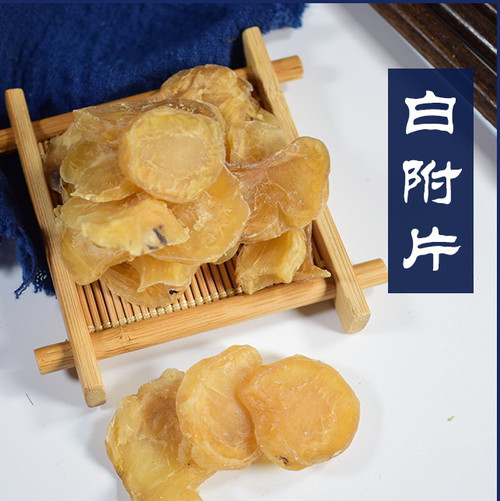Product Overview
Origin
The secondary root of perennial herbaceous plant Acontium carmichaeli Dehx. of family Ranunculaceae.
Location
Sichuan, Hubei and Hunan provinces of china.
Harvest
Collected from the last ten-day period of June to the first ten-day period of August.
The true smell and taste
Slight smell and numb the tongue.
Best quality
Good salty aconiti is marked by big root, satiation, gray-blackish color and smooth surface; good black aconiti is characterized by equality, brown-yellowish color and luster; good white aconiti is characteristic of dryness, equality, yellow-whitish and translucence.
Processing
Soaked and processed into salty, black, white, bland and soaked aconiti.
Property
Pungent, sweet, hot; toxic; heart, kidney and spleen meridians entered.
Actions
Restore yang from collapse, reinforce fire and strengthen yang, dispel cold to alleviate pain.
Indications
A. Yang exhaustion syndrome
It has the actions of strengthening heart yang to relieve palpitation, invigorating kidney yang to restore the depleted yang, so it is called "the number one for restoring yang from collapse". For yang exhaustion syndrome caused by excessive yin manifested as over sweating, over vomiting, diarrhea, clammy perspiration, clammy limbs and indistinct and faint pulse, it is usually combined with the yang-restoring and meridians-unblocking herbs. For instance it is combined with Gan Jiang and Gan Cao in Si Ni Tang from Shang Han Lun. For yang exhaustion syndrome complicated with qi collapse, it is usually combined with the qi-tonifying herbs. For instance it is combined with Ren Shen in Shen Fu Tang from Zheng Ti Lei Yao (Collected Essential of orthopaedics).
B. Yang deficiency syndrome
It has the actions of strengthen heart yang, warming spleen yang and invigorating kidney yang and is indicated for all syndromes of yang deficiency. For deficiency of kidney yang with impotence, spermatorrhoea, sterility, cold and painful waist and knee, nocturia, it is usually combined with the kidney-yang-warming herbs. For instance it is combined with Rou Gui, Lu Jiao Jiao and Du Zhong in You Gui Wan from Jin Yue Quan Shu. For deficiency of spleen-kidney yang and interior exuberance of cold and dampness manifested as epigastric and abdominal cold and pain, loose stool, it is combined with the spleen-qi-tonifying and cold-dispersing herbs. For instance it is combined with Dang Shen, Bai Zhu and Gan Jiang in Fu Zi Li Zhong Tang from Tai Ping Hui Min He Ji Ju Fang. For the syndrome of spleen-kidney yang deficiency and water-dampness accumulation manifested as dysuria and edema, it is usually combined with the spleen-invigorating and qi-tonifying herbs and edema-alleviating diuretics. For instance it is combined with Fu Ling and Bai Zhu in Zhen Wu Tang from Shang Han Lun. For deficiency of heart yang with palpitation, shortness of breath, precordial pain, it is combined with the qi-tonifying and yang-warming herbs, For instance it is combined with Ren Shen, Gui Zhi and San Qi. For common cold of wind-cold type due to yang deficiency, it is combined with the wind-dispelling and cold-dispersing herbs. For instance it is combined with Ma Huang, Xi Xin in Ma Huang Fu Zi Xi Xin Tang from Shang Han Lun.
C. Pain syndrome of cold type
It is good at treating cold arthralgia because of the strong actions of dispelling wind, warming cold and eliminating dampness to unblock meridians and stop pain. It is usually combined with the meridians-warming and collaterals-unblocking, spleen-invigorating and damp-drying herbs. For instance it is combined with Gui Zhi, Bai Zhu and Gan Cao in Gan Cao Fu Zi Tang from Shang Han Lun. For headache due to deficiency-cold, it is combined with the cold-dispersing and pain-alleviating herbs. For instance it is combined with Gao Liang Jiang in Bi Xiao San from San Yin Fang (Treatise on the three categories of Pathogenic Factors and Prescription). For abdominal pain due to cold accumulation and qi stagnation, it is combined with the qi-moving and pain-alleviating herbs. For instance it is combined with Yan Hu Suo, Mu Xiang in Xuan Fu Tang from Ji Sheng Fang.
Usage and Administrations
Decoct 3~10 g for oral use and decoct firstly for about half to one hour until its narootico-pungent taste disappears.
Cautions
It is contraindicated for heat syndrome, yin-deficiency leading to hyperactivity of yang and the pregnant because of its pungent, hot, dry and drastic properties. It must be soaked for oral use. Over-dosage, incorrect processing and decoction must be avoided.









